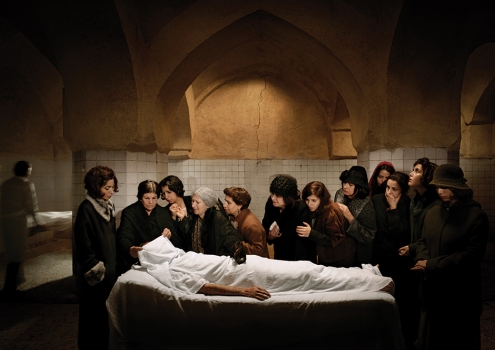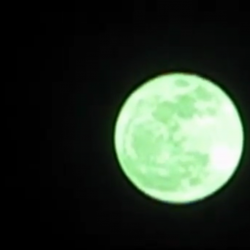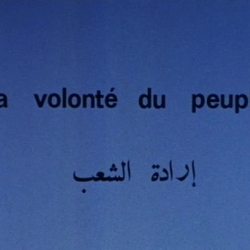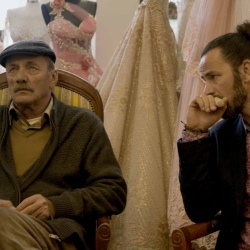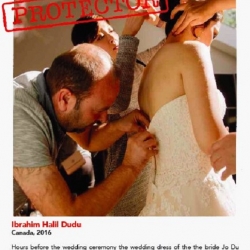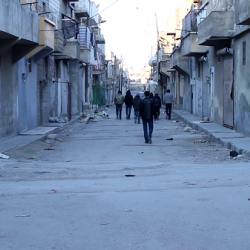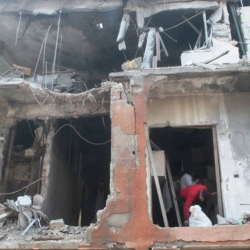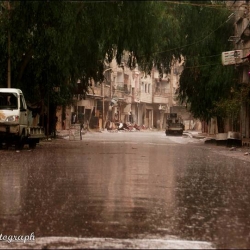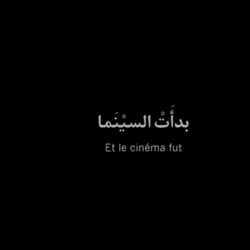28/04/2017
Author: Zeina Halabi
Photographer: Azadeh Akhlaghi
The visual artist Azadeh Akhlaghi began documenting death in the wake of the 2009 uprising, when thousands of Iranians took to the streets to protest the results of the presidential elections. She was particularly moved by the death of Neda Agha-Soltan, whose killing was captured on video and circulated widely. The visual documentation of unfathomable injustice, she thought, allowed supporters of the uprising to visualize and ultimately mourn their unfulfilled hopes for emancipation.
The Photograph as Gravestone
The footage of Neda’s shooting invited Akhlaghi to reflect on the power of visual archives and the implication of their absence on mourning. She wondered how we can mourn iconic figures whose death was never captured by cameras and preserved for memory. Akhlaghi began thinking of ways she could retroactively assign visual identity to decisive historical moments so that the community could reckon with its losses and mourn adequately.
In By an Eye-Witness, Akhlaghi recreates the tragic deaths of seventeen militants, artists, and intellectuals in staged photographs. The gallery of reconstructed photographs, she maintains, “was like a sort of imaginary graveyard, in which each photograph was a tombstone for a person whose death went unappreciated by all the regimes of Iran during the past century.” As such, her project investigates, documents, and reconstructs moments that have eluded hegemonic narratives.
The selected figures lived and died in diverse eras, yet each death occurred at a turning point in modern Iranian history. The artist begins her chronicles with the Constitutional Revolution, moves to the coup against Mohammad Mosaddegh, and covers the Islamic Revolution and the Iran-Iraq war through the years preceding the 2009 uprising. She features executed or assassinated dissidents: the Communist thinker Taqi Arani (1940), the leftist intellectual Bijan Jazani (1975), the militant student Marzieh Ahmadi Oskuie (1974), and the writer Mirzadeh Eshghi (1924). She includes people who died in absurd accidents, such as the poet Forough Farrokhzad (1967), or of natural causes, such as Ayatollah Mahmoud Taleghani (1979) and the film director Sohrab Shahid Saless (1998).
In the absence of a visual archive that documents her subjects’ deaths, Akhlaghi dives into aural and print archives. The artist spent three years searching in monographs, newspapers, pamphlets, and radio archives for the circumstances surrounding these deaths. She consulted witnesses who might still recall small but significant details—the weather that day, the number of people who gathered around the corpse—and other information that could help her reconstruct the scenes. The artist designed and produced seventeen photographs in three weeks without relying on professional actors; She allocated the budget of the project to make-up artists, costume designers, and cinematographers in order to recreate the historical moment as accurately as possible.
In In February 1940, the Communist intellectual Taqi Arani was killed in detention. Arani, the founder of the Marxist magazine Dunya, had been arrested with several of his colleagues. Known as the “Group of 53,” they founded after their release the communist Tudeh Party. (Azadeh Akhlaghi)
In February 1967, Forough Farrokhzad died in a car crash after swerving to avoid hitting a car full of schoolchildren. (Azadeh Akhlaghi)
In September 1979, shortly after the Islamic revolution, Ayatollah Mahmoud Taleghani died in his home. Taleghani was a revolutionary icon, having spent years in the jails of the Pahlavi regime. (Azadeh Akhlaghi)
In June 1977, the Islamist leftist sociologist Ali Shariati died in mysterious circumstances in London, only three weeks following his release from solitary confinement in Iran. (Azadeh Akhlaghi)
Akhlaghi concedes that although her scenes are realistic, historical precision was difficult to achieve. This is why she chose to capture “the spirit of the moment” by focusing on the state of desolation engulfing the scenes. Tampering with our sense of time, the artist appears in each of these photos wearing a red scarf—peeking at a procession, embracing a bereaved child, or running toward a corpse—an anachronism that points to the transcendence of the figures she depicts. It reminds viewers of her subjects’ timeless legacy, which she would like to inscribe in Iranian collective memory.
The reconstructed scenes thus enfold the symbolic elements that constitute the memory of the national community. They are the guardians of collective memory insofar as they enable the work of mourning, a process of reckoning with loss that ultimately frees the collectivity from enduring melancholia.
Melancholia and Its Ghosts
As Akhlaghi proposes to redress unresolved historical traumas, she articulates an understanding of history as a stable transition from the past, through the present, to the future. Communities that have experienced tragedies conceive of the present as a temporality emerging from the ruins of a past on which they build to proceed to a future of emancipation. This fluid temporal logic has framed much literature that emerged following tragedies—the writings of Palestinian writers in exile after the Nakba or post-independence Algerian literature, for instance. From the past of loss, the future shall usher in resolution and quietude. But what happens when disaster strikes again and interrupts this temporal fluidity?
Thinking about loss in the Iranian context, what happens when the Constitutional Revolution that ended the Qajar dynasty is followed by a bloody coup? When the coup is followed by tyranny? When the Islamic Revolution is followed by a long war? What happens when the long-expected moment of emancipation never comes? When the past consists of unfulfilled hopes and the future will not yield, how do we experience the present and how do we represent it visually?
In this moment of temporal disruptions and historical disquiet—a missed revolution, a bloody coup, a second revolution—the present dwells in tragedy, facing an infernal cycle of disasters. Akhlaghi embodies this state of collective paralysis. She appears in each of the seventeen photographs in her red scarf, witnessing and reacting to the tempo of unexpected deaths that remain suspended, forbidden to memory, and so impossible to mourn. The present, in which Akhlaghi stands overlooking the corpse of the past, is suspended and halted; it emerges from revolution but does not initiate it; it follows the past but does not usher us into the future. It dwells in melancholia.
In its Freudian conception and later iterations, melancholia is the affective condition that emerges from loss that has not been mourned, precisely because it has remained an open wound; it is mourning left incomplete simply because it never began. The suspension of closure instills a feeling of continuous lack, as though the unmourned and unburied object of loss haunts the present and prevents the future from materializing. In a melancholic present, the lost object is dead but the mourner does not live.
Akhlaghi rebuilds the missing archive of loss and invites the collectivity to look at the corpse lying in the photographs: to identify the object of loss, to excise it, allowing the work of mourning to begin and suspend the melancholic dwelling in the present so that the future can materialize.
The Archive’s Blind Spot
Akhlaghi’s project puts forward a compelling approach to archives and collective memory, but it also prompts us to probe her method: How were the seventeen subjects selected? Who was left out and why? A closer look reveals certain parameters. Her project focuses on ideologically distinct figures whose premature death poses the question: What if they had survived? How would their lives have transformed modern Iranian history? Although her selection includes leftist, secular, nationalist, and feminist figures, it elides other dissenting voices—Armenians, Kurds—those individuals whose legacy agitates contemporary nationalist narratives.
Should we concede to the method, another question emerges: If the absence of visual documentation of these seventeen deaths triggers a melancholic dwelling in the present, can we be certain that visual memory, as Akhlaghi seems to suggest, is capable of preventing such communal melancholy?
The years leading to the Arab uprisings and the violent repression they triggered haunt our visual memory. We remember clearly the tragedies we have witnessed—the assassination of intellectuals, the drowning and charring of children, the lynching, killing, or incarceration of women protesters. In all such instances, the photographs and footage are there but the truth is not. Although lenses captured these tragedies, the narrative surrounding them was constantly challenged, undermined, or erased. Hegemonic narratives continue to tell us that the tragedies we have seen never really took place, that what we have seen is not real. Here, melancholic affect does not feed on an absent archive—for the archive is there, so haunting in its tragedy—but rather on a tragic experience that is not validated. Akhlaghi’s icons might not have been mourned adequately, but unlike so many others, they were spared from the desecration of their corpses by hegemonic narratives.
This article was translated from Arabic, click here for the Arabic text.



